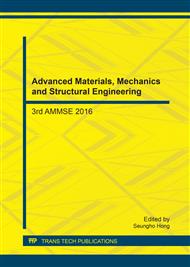p.112
p.117
p.123
p.129
p.135
p.141
p.149
p.157
p.163
Isolation of Biofilm-Forming Bacteria from the Secondary Effluent of the Wastewater Treatment Plant and its Ability to Produce N-Acylhomoserine Lactone as Quorum Sensing Signal
Abstract:
Bacterial quorum sensing (QS) is one of the cell-to-cell communication systems. N-Acyl-homoserine lactones (AHLs) are the most common QS signals and responsible for biofilm formation in gram-negative bacteria. Inactivation of QS, also referred to as quorum quenching, has been regarded as a popular strategy to control membrane bioreactor (MBR) operations because biofouling in MBR wastewater treatment systems is often caused by biofilm formation. In the present study, 24 bacterial strains were isolated from the secondary effluent of a wastewater treatment plant and AHL productivity and biofilm formation were evaluated on 8 out of 24 isolates. The isolated 8 strains can produce AHLs that only possess a long (C8-C14) acyl side chain. The representative 3 strains were selected from these isolates based on the higher activity of biofilm formation. The AHL separation analysis with a thin layer chromatography clearly showed that N-octanoyl-L-homoserine lactone (C8-HSL) and N-hexanoyl-L-homoserine lactone (C6-HSL) existed in the secondary effluent sample, while no C6-HSL producing strain was isolated. C8-HSL was identified as the product of isolate No. 6. These results suggest that the secondary effluent probably contains various cell-to-cell signaling molecules derived not only from the inhabitants but also from the other microorganisms involved in the activated sludge for the biological pre-treatment. In this secondary effluent, AHL trapping techniques can be proposed as one of the acceptable strategies for the control of the QS systems because the remaining AHLs have relatively long acyl side chain and low concentrations.
Info:
Periodical:
Pages:
135-140
Citation:
Online since:
February 2017
Authors:
Keywords:
Price:
Сopyright:
© 2017 Trans Tech Publications Ltd. All Rights Reserved
Share:
Citation:


